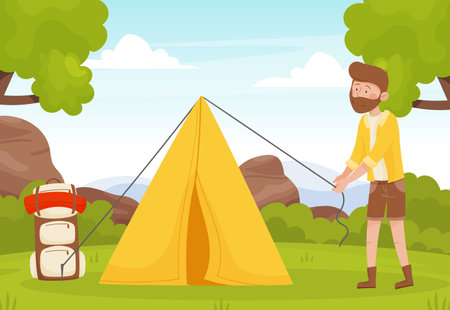Understanding Indian Camping Culture
Camping in India is more than just pitching a tent under the stars—it’s an immersive experience woven with regional flavors, traditions, and breathtaking landscapes. Unlike Western camping styles, Indian camping often revolves around vibrant local customs, spiritual connections to nature, and communal gatherings. From the lush valleys of Himachal Pradesh to the serene backwaters of Kerala, each destination offers a unique flavor that can deeply enrich your YouTube camping vlogs. To truly connect with Indian viewers, it’s essential to showcase not only the scenic beauty but also the cultural tapestry—think preparing masala chai by the riverside, sharing stories around a campfire while roasting makai (corn), or demonstrating how to set up a tent during the monsoon. Integrating authentic Indian food and rituals—like enjoying poha for breakfast in Madhya Pradesh or participating in sunrise yoga on a Goan beach—adds warmth and relatability to your vlogs. By exploring these distinctive aspects, you’ll craft content that resonates deeply with viewers across India, inspiring both seasoned campers and urban explorers to embrace their own backyard adventures.
Planning Your Camping Vlog Content
To create a memorable and successful camping vlog that truly connects with Indian viewers, careful planning is essential. This step not only ensures seamless shooting but also helps you include content that resonates with your audience’s interests and cultural expectations.
Researching Unique Locations in India
India is blessed with diverse landscapes—from the Himalayas to coastal beaches, dense forests, and rustic villages. Begin by researching spots that are both visually stunning and accessible for campers. Platforms like Instagram, travel forums, or YouTube itself can offer inspiration. Make sure to consider safety, permissions, and the seasonality of each destination. Here’s a quick comparison table to help you shortlist locations:
| Region | Popular Spots | Best Time to Visit | Special Considerations |
|---|---|---|---|
| North India | Rishikesh, Himachal Pradesh (Tirthan Valley), Uttarakhand (Auli) | March–June, September–November | Weather can be unpredictable; permits may be needed for some areas. |
| South India | Kodachadri, Wayanad, Coorg | October–February | Tropical climate; leeches during monsoon season. |
| West India | Pawna Lake, Matheran, Saputara | November–March | Lakeside camping popular; weekends can get crowded. |
| East/Northeast India | Ziro Valley, Majuli Island, Meghalaya (Dawki) | October–April | Difficult terrain; local guides highly recommended. |
Gathering Local Ingredients for Authentic Flavours
Indian food is central to any camping experience here! Plan your meals around ingredients that are locally available at your chosen spot. Not only does this support local farmers and vendors, but it also makes your vlogs more relatable. For example:
- The North: Use fresh paneer, seasonal greens (like bathua or mustard leaves), and wheat flour for rotis cooked on the campfire.
- The South: Source coconut, curry leaves, millets or rice from nearby villages for authentic South Indian flavours.
- The West: Try local grains like jowar/bajra and regional veggies in simple curries or khichdi cooked over open flames.
- The East: Incorporate bamboo shoots, fresh river fish (if permissible), and indigenous herbs into your recipes.
You can even interact with locals on camera while shopping at weekly haats (markets) or roadside stalls—these real moments will delight Indian audiences!
Planning Engaging & Culturally Relevant Activities
Beyond food and scenery, plan activities that reflect the spirit of Indian outdoor life. Consider including:
- Tent pitching challenges: Showcase different styles of tents popular in India—rooftop car tents vs. classic ground tents.
- Cultural immersion: Participate in folk music sessions around a bonfire or invite local villagers for chai and conversations about their traditions.
- Sustainable camping tips: Demonstrate eco-friendly practices like ‘carry-in carry-out’ waste management, which many Indian campers value.
- Trekking & nature walks: Explore nearby trails and share interesting facts about native flora and fauna—use Hindi/vernacular terms where possible for authenticity.
- Mental health breaks: Include moments of yoga or meditation against serene backdrops—a nod to India’s wellness heritage.
Your Planning Checklist (For Each Vlog)
- Select location & research accessibility/permitting rules.
- Create a meal plan using local ingredients—visit markets if possible!
- Craft a list of culturally relevant activities and interactions.
- Pencil in time for storytelling segments—share personal anecdotes or invite guests to do so in their mother tongue for greater connection.
Pro Tip: Stay Flexible!
No matter how much you plan, be ready to adapt. Weather changes or unexpected events often make the best stories—and Indian audiences love seeing real-life jugaad (creative problem-solving) on screen!

3. Filming Techniques for Indian Audiences
Creating engaging camping vlogs for Indian viewers goes beyond just pointing your camera at scenic landscapes. You need to capture the essence of both the adventure and the unique flavors of India. Here are some essential camera tips and cultural considerations to elevate your content:
Essential Camera Tips for Outdoor Vlogging
Always carry a compact yet sturdy tripod, as most camping locations in India have uneven terrain. Use wide-angle lenses to showcase sweeping views of valleys, mountains, or rivers—Indian audiences love seeing dramatic natural backdrops. Remember to shoot during golden hours (early morning or late afternoon) when the light is soft and colors pop. Don’t forget close-ups of local flora, fauna, and especially food preparation—these details resonate deeply with viewers who appreciate the sensory richness of outdoor living.
Capturing Local Flavors and Culture
India’s diversity is its strength. Whenever you set up camp near a village or in a new state, make it a point to film local people, markets, traditional methods of cooking, and popular regional foods (like poha in Madhya Pradesh or litti chokha in Bihar). Interact with locals and respectfully ask them about their favorite camping spots or recipes; these authentic moments build trust and add flavor to your vlog. Showcasing small details—such as brewing chai on a campfire or using locally sourced spices—will instantly connect you with Indian viewers who find comfort in familiar sights and sounds.
Include Hindi/Vernacular Commentary & Subtitles
To truly connect with Indian audiences, consider speaking in Hindi or mixing English with your mother tongue (like Tamil, Bengali, or Marathi). This makes your vlogs more relatable and accessible to a wider audience. If you’re more comfortable in English, add subtitles in Hindi or other regional languages using YouTube’s subtitle tools. When introducing unique concepts (like “leave no trace” camping), explain them in simple Hindi phrases or local dialects. Small touches like saying “namaste dosto!” at the start or end of your video can create an instant bond with viewers from across the country.
Pro Tip: Engage With Viewers in Comments
After uploading your vlog, actively engage with comments in both English and local languages. Responding to questions about locations, gear, or recipes in Hinglish (a mix of Hindi and English) shows you value your audience’s cultural context—and helps foster a loyal community around your channel.
Highlighting Desi Camping Recipes
One of the best ways to connect with Indian viewers through your camping vlogs is by showcasing delicious desi recipes that everyone loves at a campsite. Indians are passionate about food, and nothing brings people together like chai around a campfire or a hot plate of maggi on a misty morning. When you add step-by-step cooking demonstrations using local ingredients, your vlog feels both authentic and relatable. Here’s how you can feature popular Indian camping dishes:
Step-by-Step Cooking Demonstrations
Break down each recipe into easy-to-follow steps so your audience can recreate these dishes on their own trips. Don’t forget to share tips about sourcing ingredients from local markets or even foraging if appropriate. Use clear visuals, conversational Hinglish, and explain why certain spices or methods matter in Indian cooking culture.
Popular Desi Camping Recipes
| Dish | Main Ingredients | Camping Cooking Tip |
|---|---|---|
| Masala Chai | Tea leaves, milk, sugar, ginger, cardamom, cloves | Brew on a slow flame; use fresh mountain water for extra flavour |
| Maggi Noodles | Maggi, veggies (onion, tomato, capsicum), green chillies, masala packet | Add veggies for nutrition; cook in a kadai over open fire for smoky taste |
| Tandoori Paneer/Chicken | Paneer/chicken chunks, yoghurt, tandoori masala, lemon juice | Marinate overnight; skewer and roast over hot coals for authentic charred flavour |
| Poha | Flattened rice, peanuts, curry leaves, mustard seeds, onion, turmeric | Quick to prepare; sauté spices first for aroma before adding poha |
Desi Touches that Resonate with Viewers
While demonstrating these recipes, use regional language phrases (“thoda sa mirchi daal do,” “chaa ko ache se ubalne do”) and share anecdotes about why these dishes are perfect for Indian campers. Highlight any jugaad hacks—like making tandoori without an actual tandoor or brewing chai in steel tumblers. Engaging your audience with familiar flavours and cultural references will make your camping vlogs feel like home away from home.
5. Engaging with Your Viewers
If you want your camping vlogs to truly resonate with Indian viewers, making your channel interactive is a must. Engagement doesn’t just mean replying to comments—it’s about turning your audience into active participants in your journey. Here are some ways to make your viewers feel like they’re right there at the campsite with you.
Encourage Participation Through Q&As
Include a segment in your vlog or host a live session where you answer questions from your subscribers. Invite them to ask about camping in different Indian states, gear recommendations for the monsoon, or how to stay safe while camping solo. Not only does this help build trust, but it also shows you value their input and are eager to create content that speaks to their curiosity.
Share Regional Camping Tips
India is incredibly diverse—from the pine forests of Himachal Pradesh to the backwaters of Kerala. Ask your viewers to share their local camping hacks, favourite spots, or unique regional recipes in the comments. Feature some of these tips in your next video and give shout-outs to the contributors. This not only enriches your content but also creates a sense of pride and connection among your Indian audience.
Ask Viewers for Recipe Ideas
Food is central to any Indian adventure! Invite your viewers to suggest easy-to-cook regional dishes that can be prepared over a campfire. Maybe someone from Maharashtra will recommend poha, while a viewer from Bengal might suggest ghugni. Trying these viewer-suggested recipes on camera—and giving credit—makes everyone feel part of a shared culinary adventure.
Build a Camping Foodie Community
Use polls, Instagram stories, or YouTube community posts to involve your audience in decisions about upcoming trips or meals. Encourage them to share their own camping food photos using a unique hashtag—like #DesiCampingFeast. Highlighting user-generated content not only motivates more participation but also strengthens the bonds among fellow outdoor and food enthusiasts across India.
Involve Your Audience Every Step of the Way
The more you invite feedback and celebrate contributions, the more invested your viewers will become in your channel’s growth. By making engagement an essential part of every episode, you’ll turn casual watchers into loyal fans who look forward to both your adventures and their own involvement in them.
6. Optimising Your Videos for the Indian YouTube Scene
To truly connect with Indian viewers and grow your camping vlog channel, you need to play smart with YouTube’s search and discovery tools. India’s audience loves content that speaks their language—literally and culturally. Here are some desi best practices to make your camping vlogs stand out in the Indian YouTube jungle.
Use Trending Indian Keywords & Tags
Research what’s hot in the Indian outdoor, travel, and camping communities using tools like Google Trends, YouTube Search Suggestions, or even trending hashtags on Instagram. Sprinkle relevant Hindi or regional language keywords naturally in your video title, description, and tags—for example: “Indian Camping Food Recipes”, “Monsoon Camping Tips India”, or “Camping near Mumbai”. Don’t forget to add festival-related tags during Diwali or Holi season, as Indians love themed content!
Create Eye-catching Thumbnails with Local Flavour
Your thumbnail is your first impression. Use vibrant images of Indian landscapes (think Sahyadris, Himachal valleys, or Kerala backwaters), familiar foods (maybe a steaming plate of maggi or chai by the campfire), and happy faces. Add bold text in English or Hindi—words like “Desi Camping Adventure” or “Jugaad Hacks” grab attention instantly! Make sure your design is clean and mobile-friendly since most Indians watch on their phones.
Collaborate with Local Influencers & Partners
Partnerships can give your channel a major boost. Reach out to regional camping groups, food bloggers, or travel influencers—many are open to collaborations that benefit both sides. Co-create episodes about unique local experiences (like a Rajasthani desert camp cookout) or invite popular personalities for guest appearances. This cross-promotion helps you tap into new audiences who already trust these creators.
Finally, keep engaging with your audience through polls, comments, and community posts in both English and local languages. Responding to questions about where you bought your tent in Delhi or sharing tips for monsoon camping in Goa will show that you’re tuned into the Indian vibe. With consistent optimisation using trending keywords, catchy thumbnails, and strategic collaborations, your camping vlogs will feel right at home on India’s YouTube scene!
7. Showcasing Responsible Camping
When creating camping vlogs for an Indian audience, it’s important to highlight responsible and sustainable outdoor practices. As India’s outdoor community continues to grow, your content can set a positive example by emphasizing eco-friendly habits. Show your viewers how you minimise waste—like using reusable utensils, carrying cloth bags, and avoiding single-use plastics on your adventures. Make sure to demonstrate proper waste disposal methods and encourage viewers to carry back everything they bring into nature.
Respecting local customs is also crucial when exploring India’s diverse regions. Before filming at a campsite or interacting with local communities, take time to understand their traditions and seek permission where necessary. This not only builds trust but also enriches your storytelling with authentic experiences and fosters mutual respect.
Promoting the leave no trace principle should be at the heart of every camping vlog. Use your platform to educate viewers about preserving natural beauty for future generations—avoid disturbing wildlife, stick to established trails, and leave campsites cleaner than you found them. By showcasing these values in your vlogs, you help shape a more conscious outdoor culture in India, inspiring fellow adventurers to cherish and protect the country’s incredible landscapes.


